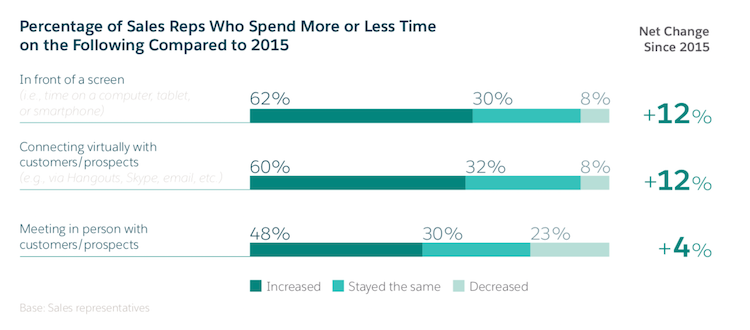Buying and selling have always been social activities. Before our lives were lit by a thousand screens full of Facebook, Twitter, and every other glowing corner of the internet, people asked others they knew for buying advice, like chatting about lawn care companies over the garden fence.
Today, social networks, forums, and online reviews have replaced the humble garden fence, and we’re all digital neighbours.
What is social selling?
Social selling is a lead-generation technique where salespeople directly interact with their prospects on social media platforms. Here’s a basic example of social selling:
1. Mike works in sales for a flooring company. On Twitter, he sees that a woman named Monique is opening a bakery in his city and she’s looking for contractor recommendations.
2. Mike sees this as an opportunity to recommend some companies he’s previously worked with and sends her a message via social.
3. Monique receives the message and sees in Mike’s social profile that he works for a flooring company. She’s been meaning to shop for flooring and puts Mike’s company on her short-list.
4. Mike sends a follow-up note on social the following week, and Monique sets an appointment to visit his showroom.
As you can see in this scenario, social selling isn’t a quick, one-and-done deal. But social channels are prime territory for connecting with new prospects and the foundations for new business relationships.
Why is social selling important?
When social media first appeared on every business’s radar, marketers quickly saw the value. Before long, most organizations were busily broadcasting on social channels in an attempt to load the sales funnel at the top end.
Today, however, winning organizations are increasingly using social tools throughout the sales process.
In fact, 78% of social sellers outsell peers who don’t use social media. Among B2B professionals, 39% said they were able to reduce account research time with social selling tools.
Whether you leverage your professional network on LinkedIn for sales prospecting or build your Twitter following to nurture relationships in your industry, social selling is a powerful tool to have in your sales arsenal.
As the pace of business accelerates, sales reps are spending more time in front of a screen. The “State of Sales” report found that reps’ time spend connecting virtually with customers has increased 3.2 times more than time meeting customers in person.

And as social media has expanded its reach over the last decade, the user base has extended well beyond Millennials. A report by Salesforce Research found that 51% of Baby Boomers and Traditionalists have interacted with a company via social media. Among Gen X, that jumps to 69% and 86% for Gen Z and Millennials. As younger generations rise in purchasing power, social selling will open up even more opportunity.
How to discover sales opportunities with social media
Now let’s dig into a few tips for social selling. Your potential customers may well be discussing their needs online — posting comments on forums, asking their followers on Twitter, and updating their status on LinkedIn.
You just need to be listening. Free tools such as Google Alerts can offer insight into what your customers are discussing online. Put them to good use, and you’ll be able to understand individual customer needs and broader market trends — stepping in to offer targeted, perfectly timed advice.
What are the steps to social selling? Here’s a quick example:
1. Jane is head of sales for a company that sells business consulting to professional services firms. She knows that firms buy from her business when they face significant changes - like sudden expansion or contraction, a merger, or consolidation.
2. Jane sets up a series of ongoing searches for trigger phrases in social media. She follows key target companies on LinkedIn, looks for new job postings, and keeps up with breaking news. She also comments on industry blogs whenever he has the insight to offer. Jane is far more likely to be in the right place at the right time when a sales opportunity does come up. Even better, she’s already hooked into the conversation and demonstrating value — a huge head start over her competitors. It doesn’t take her long to set up those searches and offer up those first few words of wisdom. She’s able to get started in social selling in no time, leaving him free to spend the evening with his family.
How to use social to build relationships with prospects and potential customers
You may be pitching the best product or service around, but that’s no guarantee you’ll win the business. Sales success depends on insight and — even harder to quantify - empathy. That’s why every good salesperson researches their prospects prior to making contact.
Before social media, this could be tough. The best a salesperson could do was check out the company’s website, wade through the annual report, and check for mentions on trade websites. Salespeople often felt like they were merely skimming the surface — with little hope of gaining the deep insight into a prospect’s needs that it takes to really tailor a pitch.
Today’s socially savvy salesperson can dive much deeper. With relatively little effort, you can discover:
- Who to target within the organization
- Who you know who’s already in contact with them
- What’s happening in near real-time
- How engaged prospects are with their own customers
- What those customers want from them — and what they’re complaining about
Armed with this information, it’s a lot easier to put together an insightful, emotive sales pitch - one that’s less “me, me, me” and more “you, you, you.” Salespeople can show how products and services directly solve the issues their prospects are facing, even issues that prospects have yet to identify themselves. Plus, they’ll have a far clearer picture of whose buy-in is critical in making the sale.
Source: Salesforce





